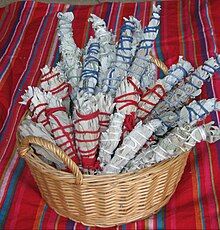Smudging
| Part of a series on |
| Indigenous rights |
|---|
| Rights |
| Governmental organizations |
| United Nations initiatives |
| International Treaties |
| NGOs and political groups |
| Issues |
| Countries |
| Category |

A smudge stick is a bundle of dried herbs, usually bound with string into a small bundle. The herbs are later burned as part of a ritual or ceremony. Plants that are often used include sage and cedar.
The American English term "smudge stick" is usually found in use among non-Indigenous people who believe they are imitating North American Native sacred ceremonies. However, the herbs used in commercial smudge sticks, and the rituals performed with them by non-Natives, are rarely the actual materials or ceremonies used by traditional Native Americans. Using scent and scented smoke (such as incense) in religious rites is an element common to many different cultures worldwide, but the details and spiritual meanings are usually unique to the specific cultures and ceremonies in question.[1][2]
Smudging in North American Native Traditions
In some First Nations[3] and Native American ceremonies, certain herbs are traditionally used to purify or bless people and places. For instance, some cultures use the smoke of burning red cedar as part of purification and healing ceremonies.[4] However, the same herbs that are burned by one culture may be taboo to burn in another, or they may be used for a completely different purpose. When specific herbs are burned ceremonially, this may or may not be called "smudging," depending on the culture. Boughman tells of smudging done in hospitals to "cleanse and repel evil influence."[5]
The practice of burning sacred herbs for ceremony has also raised issues about the religious freedom of Native Americans. Native American students in college dorms, for example, have at times faced harassment and been forbidden from smudging due to university policies that prohibit the burning of candles or incense in college dorm rooms.[6]
Traditionally, when gathering herbs for ceremonial use, care is taken to determine the time of day, month, or year when the herbs should be collected; for example, at dawn or evening, at certain phases of the moon, or according to yearly cycles. Gertrude Allen, a Lumbee, reported that her father, an expert in healing with plants, stated that sage varies in potency at different times of the year.[5] Most commercial gatherers do not follow these traditions.
Smudging in other cultures
A fragmented version of smudging has been adopted into a number of modern belief systems, including many forms of New Age and eclectic Neopagan spirituality. This has been protested and is seen as cultural appropriation by people from the traditional cultures whose practices are being imitated.[1][2] While the burning of incense, and the use of sacred fires that put off smoke, is found in many cultures worldwide, those activities are not known as "smudging." Smudging with sage, or other herbs sacred to Indigenous Peoples, is a different and culturally-specific practice.
Cultural appropriation of Native American spiritual ceremonies has been addressed by the United Nations in the Declaration on the Rights of Indigenous Peoples, which advocates for protection of traditional knowledge and Indigenous intellectual property.[7]
Composition of smudge sticks
Smudge sticks are often sold commercially, despite traditional prohibitions against the sale of spiritual medicines like white sage.[1][2] The sticks may be made of a single herb or a combination of several different herbs; often these herbs are not found bundled together in traditional use, and their use is not universal to all, or even most, Native cultures. In some Native American cultures the burning of these herbs is prohibited. Other commercial smudge sticks may contain herbs not native to North America, as well as substances that are toxic when burnt. Common sage is frequently used by non-Natives.
See also
References
- ^ a b c Hobson, G. "The Rise of the White Shaman as a New Version of Cultural Imperialism" in: Hobson, G., ed. The Remembered Earth. Albuquerque, NM: Red Earth Press; 1978: 100-108.
- ^ a b c Aldred, Lisa, "Plastic Shamans and Astroturf Sun Dances: New Age Commercialization of Native American Spirituality" in: The American Indian Quarterly issn.24.3 (2000) pp.329-352. The University of Nebraska Press.
- ^ "First Nations teen told to stop smudging or face suspension from school". CTV.ca. Retrieved 2014-02-06.
- ^ Lyon, William S. (1998). Encyclopedia of Native American Healing. W.W. Norton & Company, Inc. p. 173. ISBN 0-393-31735-8.
- ^ a b Boughman, A. L., & Oxendine, L. O. (2003). Herbal remedies of the Lumbee Indians. Jefferson, N.C., McFarland.
- ^ Stokes, DaShanne. 2001. "Sage, Sweetgrass, and the First Amendment." The Chronicle of Higher Education, May 18, pp. B16
- ^ Working Group on Indigenous Populations, accepted by the UN General Assembly, Declaration on the Rights of Indigenous Peoples; UN Headquarters; New York City (13 September 2007) p. 6.
